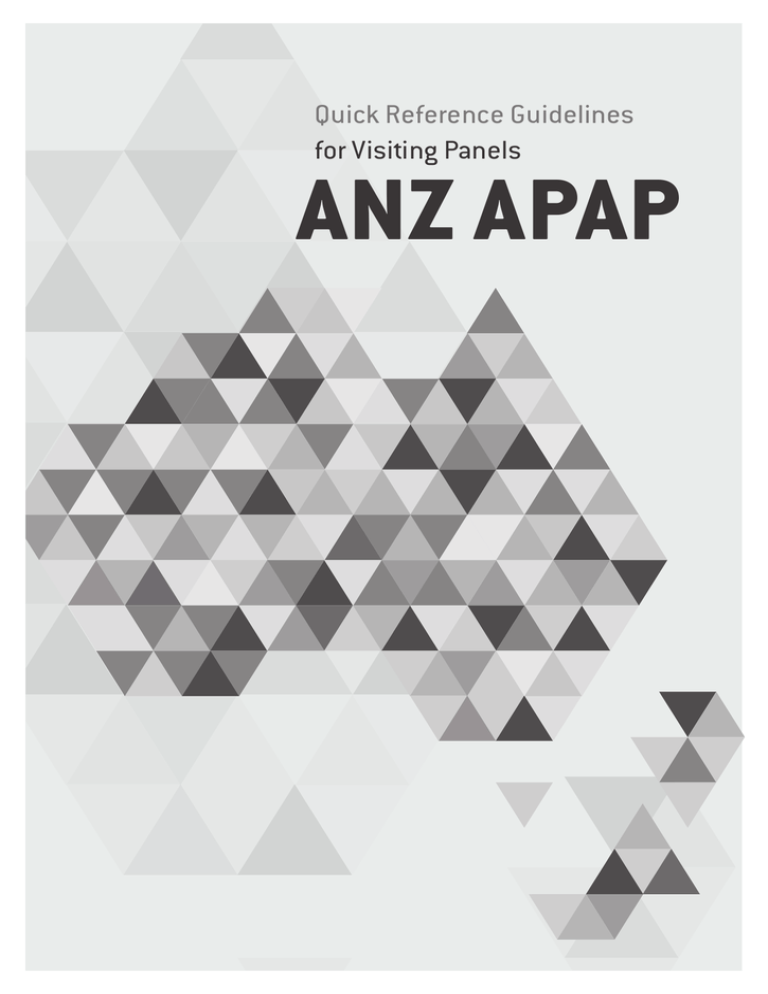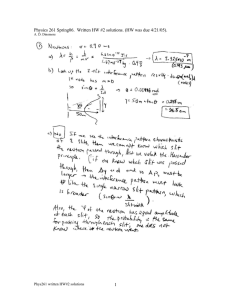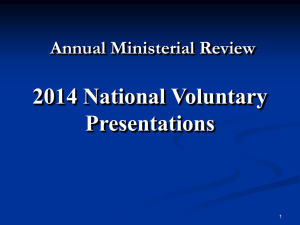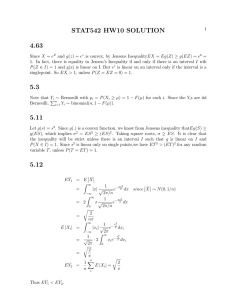ANZ APAP Quick Reference Guidelines
advertisement

Quick Reference Guidelines for Visiting Panels ANZ APAP 1.Introduction The Architects Accreditation Council of Australia (AACA) and the Australian Institute of Architects (the Institute) have jointly published the Australian and New Zealand Architecture Program Accreditation Procedure (ANZ APAP): www.architecture.com.au/ANZAPAP ANZ APAP outlines the procedures for visits to Australian and New Zealand architecture programs to provide a recommendation regarding accreditation to the relevant authorities. These principal visits are referred to as National Visiting Panels (NVP). 2. Purpose of these Guidelines These guidelines summarise the processes and roles and responsibilities of members of visiting panels as outlined in detail in the ANZ APAP document. Panel Members of visiting panels should read this document in conjunction with the procedure document. 3. Who Accredits Accreditation of architecture programs is only provided by the respective state and territory registration authorities in Australia and the New Zealand Registered Architects Board (NZRAB) in New Zealand. Accreditation of an architecture program by these bodies is based on their consideration of the recommendations from the NVPs. Once an architecture program is accredited the exit qualification and the period of accreditation is included in a national list prepared by the AACA or the New Zealand equivalent as appropriate. 4. Accreditation and Recognition The 2012 review of the procedures clarified the prime purpose of the NVP which is to provide a recommendation for Accreditation. The previous purpose of the procedures had an added requirement of recommending Recognition for the purpose of membership to the Institute. The revised procedures enable the Institute to accept a recommendation for the purposes of Accreditation in respect of membership. 5. Types of Visits The NVP occurs for every accredited architecture program at the end of the accreditation period (generally between 3–5 years). The Interim Review Panels (IRP) are short visits that occur between NVPs as required. The other visit available is the Preliminary Assessment (PA) for new or substantially altered architecture programs as well as programs with an expired accredited status of more than 1 year. 6. Program Visit Panel members receive information provided by the architecture program regarding comprehensive descriptions of program content, methodologies and resources. This material is made available to the ANZ APAP Manager, as the secretariat for the process, eight weeks before the proposed visit and distributed to the panel membership. An NVP will typically last three days and include the following: `` Meetings with the program leader and senior colleagues `` Meetings with program staff regarding specific subject areas and content `` General meeting with staff (program leader and senior colleagues excluded) `` Meeting with students and recent graduates `` Meeting with Tertiary Education Provider, typically Vice Chancellor `` Inspection of facilities `` Exhibition of student work `` Presentation of curriculum content of subjects and examples of student work from these subjects. The student work should be a range of assessed work that achieved excellent, good and bare pass grades for all subjects These presentations, meetings and inspections are intended to give the panel the opportunity to assess the program against the aforementioned criteria and to ask questions for clarification regarding submitted material and information. The meeting with the program leader gives the panel the opportunity to understand the place of the architecture program within the broader university context. 7. NVP Membership Panel members are invited and selected by the ANZ APAP Manager from a Standing Panel of persons with appropriate expertise. Generally the NVP will consist of a mix of practitioners, architect academics and a student. The visiting panel is an entity in itself and not a collection of individuals. It must be seen this way as there will be only one report and recommendation as a consensus outcome of the visit. Irrespective of which body nominates a person to the Standing Panel, once that person agrees to participate they are an equal member of an NVP and should not consider themselves a representative of their nominating organization. The role of the members is to work towards this outcome. 8. NVP Chair and Briefing of NVP The Chair of the NVP is selected by agreement between the AACA and the Institute. The role of the Chair is to guide and manage the process of the NVP and coordinate the completion of the report within the required timeframe. Prior to the visit the Chair will organize a meeting to brief the panel membership on the specific NVP, review documentation, allocate subject areas to members and to field questions and provide clarification on the processes. In most cases this meeting can occur immediately prior to the NVP. Some programs may require additional monitoring and the NVP would benefit from a more thorough briefing and discussion. In this case a teleconference will be organized by the ANZ APAP Manager at least three weeks before the NVP. 9. Benchmark Academic Pathway (BAP) The program provider must nominate a BAP of study which a substantial cohort of students will undertake. As a guide a minimum 30% of students graduating will have undertaken the BAP. The BAP will be the substantive program leading to the professional qualification that the NVP will assess against the criteria. While there may be alternative program pathways, the BAP will be the benchmark against which any alternatives will be assessed to ensure relative equality in content and efficacy. 10. Criteria for NVP Review For the NVP to recommend accreditation the architecture program must provide details of structure, subject material and student work that demonstrates that graduates will have the relevant competencies outlined in the National Competency Standards in Architecture (NCSA). To assist in this assessment the program providers are required to ‘map’ the relevant competencies against subjects and subject areas for the NVP to assess. It is worth reiterating that the NCSA includes all the competencies required for registration as an architect and that only a portion are required for architectural graduates to have achieved. The required competencies for the NVP are outlined in the NCSA and NCSA Integrated Framework: www.aaca.org.au/publications 11. Action Items The NVP report has a section that outlines Action Items to be undertaken by the program providers. These relate to deficiencies that need to be addressed to either achieve a recommendation of Accreditation at the next NVP or to maintain a recommendation of Accreditation. These items must relate directly to the relevant competencies. These items must not include peripheral issues outside of the competencies. Broader issues are to be discussed in the section of the report set aside for Professional Advice. 12. Professional Advice The NVPs have the opportunity to provide advice to the program provider. The nature of this advice can be based on a number of contexts including the Institute’s Education Policy. The Professional Advice can also provide comment on circumstances or elements of the program that may prevent students from achieving the competencies over the forward Accreditation period. These could include aspects of program and subject methodologies including assessment of the physical and human resources associated with the program. Professional Advice does not form any part of Accreditation recommendations. It is intended to offer dialogue between the educators, the panel and practice. This advice should not be limited to concerns the NVP may have but should also include positive aspects which the NVP would wish to acknowledge and encourage. The required criteria for Professional Advice is outlined in the Institute’s Education and Research Policies: www.architecture.com.au/education-research-policies 13. Delivery of NVP Report The program leader will signify acceptance of the report with regard to matters of fact at the end of the visit but has a further seven days to inform the ANZ APAP Manager of any errors of fact in the report. The report minutes of meetings with staff and students may contain material with which the program provider does not agree. If the NVP is satisfied the minutes are an accurate reflection then they will be included, the program provider cannot require the NVP to amend or reword the content. The program leader has the opportunity to provide a response to be appended to the report up to seven days after the visit. The report is forwarded to the relevant accrediting authority which must within 28 days, accept or reject the NVP report recommendations. A copy of the report is provided to the Institute and the AACA. 14. Presenting the NVP Report to the Program Provider The presenting of the NVP Report to the staff and students of the program at the completion of the NVP should be an overview of the entire report including the bringing out of positive aspects of the program as well as the Action Items and Professional Advice. 15. NVP Member Behaviour Members of the NVP are expected to behave in a professional and responsible manner. They should not offer opinions to staff or students during the course of the NVP that may indicate potential outcomes of the NVP or specific criticisms. The purpose of the visit is to encourage better program providers and improve standards of graduates while recognizing that these aims can be achieved in a wide variety of ways within the different programs. 16. Help The NVP or individual members can get assistance where required. The first call would be to the ANZ APAP Manager. For issues beyond questions of procedure and management requests for help or advice will be forwarded to the ANZ APAP Steering Committee through its Chair. The ANZ APAP Manager can be contacted on ANZAPAP@architecture.com.au architects accreditation council of australia australian institute of architects PO Box 236 Civic Square ACT 2608 Australia Tel: +61 2 6230 0506 Fax: +61 2 6230 7879 Email: registrar@aaca.org.au PO Box 3373 Manuka ACT 2603 Australia Tel: +61 2 6121 2000 Fax: +61 2 6121 2001 Email: ANZAPAP@architecture.com.au www.aaca.org.au www.architecture.com.au Architects Accreditation Council of Australia




